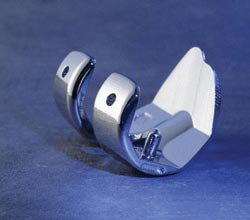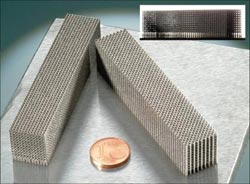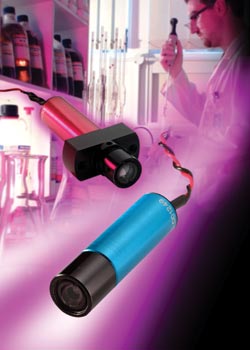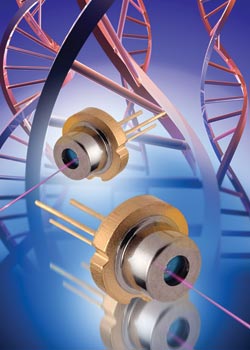Looks Up, Despite a Down Economy
Advances in technology are creating new opportunities in certain segments of the laser market, despite the current economic slowdown. What follows are reports on some of those areas where those advancements are besting the downturn.
Rapid manufacturing
Fibre lasers are steadily moving in on traditional laser applications – and developing totally new markets. John Tinson, vice president of sales at SPI Lasers in Southampton, UK, told me that the current largest sales sector is metals and plastics marking, for applications such as computer keyboards and telephone keypads. Fibre lasers also have distinct advantages over Nd:YAG lasers in micro- and macromachining because their high-quality beam allows them to make narrow cuts, resulting in better accuracy and less waste. But the biggest growth segment in Europe, Tinson said, is in high-value, low-volume areas such as medical and dental implants, and specialized parts for fighter aircraft and Formula One racing.

Fibre lasers produce medical implants, such as this replacement knee joint, by rapid manufacturing in titanium or cobalt chrome. Courtesy of EOS GmbH Electro Optical Systems of Munich, Germany.
Most European governments are sponsoring “rapid manufacturing” technology, which transforms a design in a CAD file directly into a finished article in 12 to 24 hours, building up the material in the component by laser sintering a fine metallic powder. The process is often called “selective layer melting.” Originally named “rapid prototyping,” its function was product visualization. However, thanks to technological advances, the method now produces components whose quality rivals that of conventional manufacturing. The technique produces individual medical implants such as hip replacements in a few days, as compared with conventional methods, which require several months of design and production, plus an expensive tooling cycle. The stability and focusing ability of fibre lasers, along with their continuous-wave (CW) quality and freedom from thermal lensing, are advantageous and enable production of complex parts from various metals ranging from stainless steel to titanium, with low wastage.

A micro heat exchanger is built up by laser sintering a fine metallic powder. It involves 3200 undercuts and is impossible to machine by traditional methods. Courtesy of MCP HEK GmbH of Lübeck, Germany.
For more traditional materials processing, such as welding, cutting, marking and micromachining, the beam quality of the fibre laser allows a narrow cut, melting less material and consuming less power. A fibre laser cuts faster than an Nd:YAG of the same power. In the Nd:YAG, the light is generated in a crystal rod or disc and then led out via a coupled fibre delivery cable. In fibre lasers, the fibre is the gain medium. It has fibre Bragg gratings at either end to act as mirrors. Its inherent geometry produces the high-quality beam, and it requires no alignment. This yields more than 30,000 hours of maintenance-free operation with spatial and temporal stability, and no warm-up is required.

Fibre lasers with nanosecond pulse rates allow precision layer removal to produce coloured keypad marks for mobile phones. Courtesy of SPI Lasers of Southampton, UK.
In October 2008, SPI Lasers became part of the Trumpf Group of Ditzingen, Germany. “The acquisition offers SPI Lasers and Trumpf the opportunity to enjoy excellent market growth in the field of fibre lasers in the future,” said Peter Leibinger, vice chairman of the managing board and head of the Laser Technology and Electronics Div.
Virus detection
Global Laser Ltd. of Abertillery, Wales, provides laser products for a wide range of applications and is experiencing increased demand in various markets, including the medical, machine vision and military sectors. The company also works with clients to offer customized lasers that push the capabilities of existing technology.
Global Laser’s red and infrared lasers are normally used as illumination/alignment sources. One flagship product is the Firefly green laser, which forms the basis of groundbreaking medical systems for detecting airborne and blood-based viruses. The standard Firefly is a rugged and stable green laser module that features built-in electronic control and reliable output performance, high boresighting accuracy and a high-quality spot over a wide range of distances.
There is an increasing demand for scanners to detect airborne viruses. For example, complex detection systems use lasers to detect anthrax and have the potential to track the newly emerging threat of swine flu. Global Laser also works with a range of companies dealing with eye scanning, which helps detect cancers long before conventional methods do.
Shorter wavelengths for biotechnology
Biotechnology has suffered less than most in the current downturn, and Cobolt AB of Solna, Sweden, has expertise in this field. The company develops lasers for instruments that analyse genes, proteins and cells, and that assist in diagnostics and drug development. It recently released the Fandango 515 nm, for instance, which provides up to 100 mW of CW output for spinning-disc confocal microscopy and high-speed plate reading. It replaces argon-ion lasers for exciting fluorescence in markers like yellow fluorescent protein, Alexa 514 and Oregon Green.
Cobolt is also developing lasers at shorter wavelengths. “There is a lack of good ultraviolet lasers for certain fluorescent markers,” said Håkan Karlsson, CEO. “Unless they combine compact size and efficient cost with the correct wavelength and power, users will choose alternative light sources.” In January, the company brought out the Zouk, a diode-pumped solid-state laser outputting 10 mW CW at 355 nm in a high-quality beam. It is packaged for robustness and long life and is more compact and power-efficient than argon/krypton ion lasers or other CW solid-state alternatives in the 350- to 360-nm range.

Laser therapy and blood analysis applications use near-IR laser modules from Photonic Products. Courtesy of Photonic Products.
Dieter Gebhardt of Photonic Products EU of Gröbenzell, Germany, is in charge of its distribution network for Germany, Austria, Switzerland and some Eastern European countries. He sells visible and near-IR laser diodes from Opnext, Sanyo and Sony for laser sensors, automotives and laser therapy, and he told me that there are some new lasers for skin treatments. Another emerging area is Blu-ray technology, using precisely focused blue-violet lasers at 405 nm for high-density data storage. Currently, DVDs employ a red laser to read and write data, but a group of consumer electronics companies has developed the next-generation Blu-ray disk format to store larger quantities of data, including high-definition video, on the same-size disk.

Sanyo 405-nm blue-violet laser diodes enable biomedical instrumentation, medical imaging and fluorescence sensing, as well as the emerging Blu-ray technology for high-density data storage. Courtesy of Photonic Products.
In the early stage of development are RGB projectors for mobile phones, to project pictures onto a wall a metre or so away. The challenge is to evolve low-cost, low-power consumption and very compact lasers at the correct wavelengths. Very cheap laser diodes are currently available for red, and some exist that are suitable for blue, but they are more expensive. Suitable green lasers do not at present exist: Diode-pumped solid-state lasers supply green wavelengths, but they consume too much power and are too big.
Organic LEDs are under development, with a large potential market for display technology and TV. In present-day screens, the backlight is the main power consumer. Organic LED screens can work without backlight, and the manufacturing process is more cost-efficient compared with that for a standard LED.